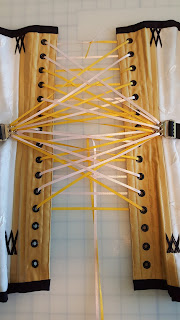Historical Sew Monthly
May 2019
Florals: Create an item that features flowers in some way.
The Dreamstress
Imagine that in the 18th century a young lady, or even a young girl maybe even 5 or 6 years old, might have been started on her sewing journey She might have sat with her hoop, a square of linen, some scraps of ribbon and thread and created her first project. She may have practiced on scraps of fabric for many days before and now she will create something special just for herself. Her mother would be sure that any mistakes would be hidden from the world to keep budding confidence high and so a pocket would be a perfect. Personal, used daily, something of which to be proud.
With that image in mind I embark on my 18th century sewing journey. Something simple while learning the basics of handstitching a complete project, something beautiful, and something useful. And something I, too, can keep hidden from the world.
My question was this: Was ribbon embroidery a form of embellishment in the 18th century? The answer is yes with my first find, a baby bodice from the RISD Museum 1790.
And this Woman's Stomacher from the LACMA Collections 1775.

With that image in mind I embark on my 18th century sewing journey. Something simple while learning the basics of handstitching a complete project, something beautiful, and something useful. And something I, too, can keep hidden from the world.
My question was this: Was ribbon embroidery a form of embellishment in the 18th century? The answer is yes with my first find, a baby bodice from the RISD Museum 1790.
Link: 1775 Woman's Stomacher
Feeling confident that I am on an historical path I begin. Using the pocket pattern from Simplicity 3635 I begin my first 18th century project.
I find online a sample of a monogram using Jasmine flowers surrounding the J and Mallow flowers surrounding the M. Also online is a supplier of silk ribbon in 4mm widths perfect for ribbon embroidery. I create my color choices and practice a bit with some polyester ribbon.
There is a wealth of information online for stitch instruction both in verbal and visual form. While I may not have a mother sitting beside me guiding my hand, I have the online community with me at my beck and call. Such a wonderful time we live in!
I trace my monogram onto an ivory linen fabric.

And within hours I have learned the twisted straight stitch and twisted stem stitch for the initials, a straight stitch, ribbon stitch, and French knot for the flowers and leaves. By mistake I've also learned the pierced loop stitch which I rather love. Sometimes our mistakes are our best teachers!
 |
| J is for Jasmine |
 |
| M is for Mallow |
I learn the basic backstitch while encasing the pocket opening in bias binding.
Needing some confirmation of my stitching I post this photo to the 18th Century Sewing group on facebook and receive some great tips and feedback on my progress. When it comes to the online community, we are never alone unless we choose to be!
This is the back side of the backstitching...
...and this is the front side in the bias binding.
The bias binding is placed around the entire outside of the pocket front and back, the upper band is sewn on, and a length of tape is strung through the top to be tied around the waist. The pocket is finished and ready to carry the essentials of daily life. I'm pleased to have made this with all historical techniques and fabrics as close as possible in this time and ready to continue down this 18th century creative path.
Historical Sew Monthly
The Challenge: Florals
What the item is: 18th century silk ribbon embroidered pocket
How it fits the Challenge: Silk ribbon embroidered flowers with each flower representing the initial.
Material: Linen, silk ribbon
Pattern: Simplicity 3635
Year: 18th Century
Notions: Thread, tape
How historically accurate is it? This is where I feel a sense of accomplishment. While I strive for an historical impression in much of my work, it is difficult to feel I have reached the goal of historical accuracy due to fabric and time constraints. With this small project I can say that from the fabric to the stitching I have maintained a true accuracy.
Hours to complete: 10 hours
First worn: Costume College 2019
Total cost: $10
.jpg)




























































